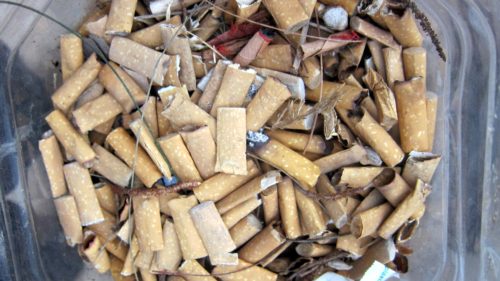15 Oct Can Cigarette Butts Be Recycled Into Bricks and Concrete?
MedicalResearch.com Interview with:
Abbas Mohajerani BsEng, MsEng, PhD, FIEAust, MAGS. MACI
Senior Lecturer
School of Engineering, Civil and Infrastructure Engineering
RMIT University
Melbourne Victoria Australia
MedicalResearch.com: What is the background for this study? What are the main findings?
Response: I knew about the harmful chemicals in cigarette butts and was not happy to see them everywhere in the environment, in our footpath, parks, and rivers. Cigarette butts (CBs) contain a large number of toxic to highly toxic chemicals and stay in the environment for a long time. Decomposition of CBs can take from a couple of months to many years depending on the environmental factors.
Cigarette butts are one of the most common types of waste found around the world. Currently about 6 trillion cigarette butts per year are deposited somewhere in the environment. This is equivalent to an estimated mass of over 1.2 million tonnes of Cigarette butts each year. And this is expected to increase significantly by 2025, mainly due to an increase in the world population.
In 2005, I started to think about different ways to recycle CBs in construction materials, and the first idea which struck me was to recycle them in fired clay bricks.
After several years of research, we came up with a proposal, that if every brick manufacturer were to produce 2.5% of their bricks with 1% Cigarette butts incorporated, all CBs produced worldwide could be recycled. A 1% CB content would have very little effect on the physical and mechanical properties of the brick. And the estimated firing energy saved by incorporating 1% CBs into clay bricks is about 10%. That is a very significant reduction in the firing energy.
This proposal was published in the journal of Waste Management in May 2016.
The 2nd idea which was in my mind from the beginning was recycling Cigarette butts in asphalt concrete. We started to work on this idea in 2012. In this research, we encapsulated the cigarette butts with bitumen and paraffin wax to lock in the chemicals and prevent any leaching from the asphalt concrete. The encapsulated cigarette butts were mixed with hot asphalt mix for making samples.
For the first investigation, involving encapsulation of CBs with bitumen, using 10 kg/m3 and 15 kg/m3 of CBs in an asphalt mix gave results that satisfied the requirements for light, medium and heavy traffic conditions. For the second investigation, involving encapsulation of CBs with paraffin wax, the changes in mechanical and volumetric properties for 10 kg/m3 CBs satisfied the light traffic conditions for road pavements.
MedicalResearch.com: What should clinicians and patients take away from your report?
Response: The reduction in bulk density of asphalt concrete caused by incorporating encapsulated Cigarette butts , increases the porosity, particularly when encapsulating in higher grade bitumen, which, in turn, lowers its thermal conductivity. This helps reduce the Urban Heat Island effect in urban environments.
Encapsulated cigarette butts developed in this research will be a new construction material which can be used in different applications and lightweight composite products. Some of the results from this research have been published in the Journal of Construction and Building Materials this year.
MedicalResearch.com: What recommendations do you have for future research as a result of this study?
Response: This research will continue until all questions and issues related to the collection, processing and large-scale recycling of cigarette butts in fired clay bricks, asphalt concrete and other construction materials have been resolved.
I have been dreaming for many years about finding sustainable and practical methods for solving the problem of cigarette butt pollution.
MedicalResearch.com: Is there anything else you would like to add?
Response: Destiny is no matter of chance, it is a matter of choice.
Currently the annual increase in waste production globally seems to be much higher than the annual increase in waste recycling. This means that the huge negative impacts from thousands of different waste materials on the natural environment is increasing alarmingly. That is why Reducing waste, Re-using waste and Recycling waste should be taken much more seriously now. This is essential for the environment and the future of humanity. And much more research is needed to develop sustainable ways to recycle waste.
Sometime in the future, all waste materials will be recycled. Let’s make a meaningful contribution to make it happen sooner.
MedicalResearch.com: Thank you for your contribution to the MedicalResearch.com community.
Citation:
Abbas Mohajerani, Yasin Tanriverdi, Bao Thach Nguyen, Kee Kong Wong, Harin Nishamal Dissanayake, Lachlan Johnson, Damian Whitfield, Guy Thomson, Eilaf Alqattan, Ahmad Rezaei. Physico-mechanical properties of asphalt concrete incorporated with encapsulated cigarette butts. Construction and Building Materials, 2017; 153: 69 DOI: 10.1016/j.conbuildmat.2017.07.091
References
Media release August 2017
Media release May 2016
https://www.rmit.edu.au/news/all-news/2016/may/how-brickmakers-can-help-butt-out-litter
Physico-mechanical properties of asphalt concrete incorporated with encapsulated cigarette butts
http://www.sciencedirect.com/science/article/pii/S0950061817314241
A practical proposal for solving the world’s cigarette butt problem: Recycling in fired clay bricks
http://www.sciencedirect.com/science/article/pii/S0956053X16300988
The urban heat island effect, its causes, and mitigation, with reference to the thermal properties of asphalt concrete
http://www.sciencedirect.com/science/article/pii/S0301479717303201?via%3Dihub
Note: Content is Not intended as medical advice. Please consult your health care provider regarding your specific medical condition and questions.
[wysija_form id=”1″]
Last Updated on October 15, 2017 by Marie Benz MD FAAD


